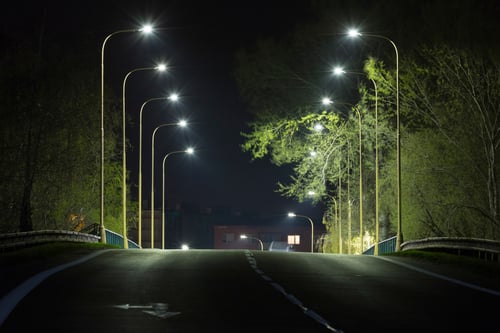LED lighting is typically associated with saving electricity, but the technology also offers safety advantages over older types of lighting. LED luminaires are safer for installers and maintenance personnel who directly handle them, and their performance characteristics also improve overall site safety. Some building upgrades are effective on some properties and ineffective on others, but upgrading to LED lighting is almost always a good decision.
Improve building efficiency and safety with an LED lighting design.
LED lighting uses safer, lighter materials
Incandescent, fluorescent, and HID bulbs use glass, which means they can break on impact. This is dangerous for everyone involved, as shards of glass are thrown in all directions. On the other hand, LED lamps can be manufactured entirely from unbreakable materials, eliminating this risk. This is a significant advantage in applications where food and other sensitive products are handled, as the risk of contamination with pieces of glass is eliminated.
For a given type of luminaire and application, LED products tend to weigh less than conventional luminaires, which makes them easier to lift and manipulate. For example, HID luminaires are heavy because they use ballasts with iron cores, but this component is not necessary in LED luminaires for the same applications. Conventional luminaires with aluminum reflectors typically weigh around 12 kg, while equivalent LED luminaires only weigh around 6 kg.

Consider that some LED products are manufactured with glass components, so do not assume that all bulbs are free from shatter. This is common in decorative applications, where LED fixtures are often designed to replicate older bulbs. For example, there are glass lamps with LED filaments that imitate an incandescent lamp.
LED luminaires are also less likely to cause accidents during operation. Compared to older lighting types, the surface of LED bulbs operates at a lower temperature and only the heat sink behind the bulb gets very hot. If an LED bulb is accidentally touched, the risk of burns is much lower. The lower operating temperature of LED lamps also contributes to fire safety.
LED lighting can run longer with backup power
The reduced energy consumption of LED lighting is not just an energy-saving feature. If a building must run on backup power due to an emergency or service outage, LED lighting can last longer with available power sources, which are typically batteries or diesel generators.
- Suppose a commercial office uses fluorescent lamps with a power consumption of 90 watts per lamp, equipped with batteries.
- If these devices are adapted with LED tubes and consumption is reduced to 45 watts per device, the existing battery capacity will last twice as long.
LED lighting provides more time to evacuate a building while running on backup power during an emergency. The same applies to emergency lighting, which is only activated when the electricity supply is interrupted.
LED lighting can be reactivated with zero cool down period
HID lighting is commonly used in outdoor and industrial environments due to its powerful output, but it has a significant limitation: if the bulbs are disconnected from the power source, they require several minutes to turn on again and reach full brightness. Even a few minutes in the dark can be dangerous in an industrial facility with heavy machinery in operation or in a parking area with continuous traffic.
LED lighting can instantly reset when turned off, eliminating the risk of leaving an area in the dark for several minutes. This also makes LED lighting more suitable for automation as it can be activated and deactivated without delay.
Heavy Duty LED Lighting Applications
There is a common misconception that LED products are more fragile than older lighting systems, when in fact they are sturdier. Conventional lamps have filaments and electrodes that can be damaged by vibration when installed close to large industrial equipment.
LED lighting offers excellent performance in the oil and gas industry: it has a reduced heat production and does not produce sparks when activated, which minimizes the risk of explosion. However, consider that not all LED products are safe for hazardous environments, they must be specifically rated for these applications.
The long lifespan and robustness of LED lighting is an excellent feature in heavy-duty applications where a sudden lighting failure causes serious risks to personnel. When lighting is critical to safe operation, the best option is to use the strongest type available – LED.

